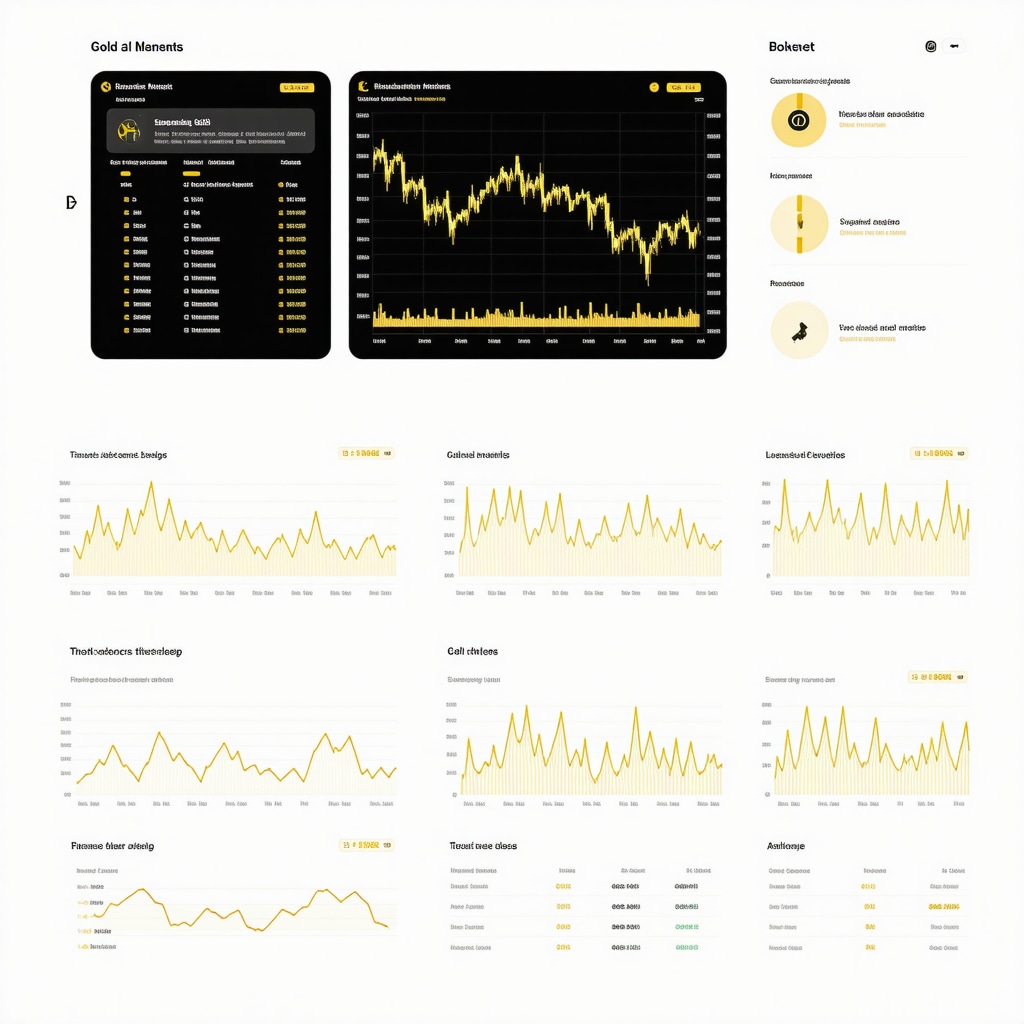Harnessing Gold ETFs and Mutual Funds for Dynamic Diversification Strategies in 2025
In the rapidly evolving landscape of global finance, investors are increasingly turning to sophisticated instruments like gold Exchange-Traded Funds (ETFs) and mutual funds to achieve optimal diversification. These vehicles not only offer liquidity and convenience but also serve as vital tools in hedging against economic volatility and inflationary pressures. As we approach 2025, understanding the nuanced application of these investment options becomes essential for both seasoned and emerging investors seeking to enhance portfolio resilience.
Why Gold ETFs and Mutual Funds Are Essential for Sophisticated Diversification
Gold’s unique position as a non-cyclical asset with intrinsic value has cemented its role in diversified portfolios. Unlike physical gold, ETFs and mutual funds provide exposure to gold’s price movements without the logistical challenges of custody and storage. Furthermore, they enable investors to access gold indirectly through a range of strategies, including passive tracking and active management, tailored to specific risk appetites and investment horizons. The proliferation of thematic funds focused on gold-mining stocks and bullion-backed ETFs in 2025 exemplifies this trend.
Advanced Techniques for Integrating Gold Instruments into a Broader Portfolio
Expert investors leverage a combination of tactical asset allocation and dynamic rebalancing to optimize exposure to gold. For example, during periods of economic uncertainty or rising inflation expectations, increasing allocation to gold ETFs can serve as a hedge, while reducing exposure during bullish equity cycles. Additionally, blending gold mutual funds with other commodities and alternative assets enhances diversification, mitigating sector-specific risks. Incorporating insights from central bank gold purchase trends informs strategic timing and allocation decisions in this context.
Addressing the Complexities of Gold ETF and Mutual Fund Selection
Selection criteria extend beyond expense ratios and liquidity. Investors should analyze fund holdings, management track record, and exposure nuances—such as bullion-backed versus gold-mining-focused funds. For instance, the nuances of gold-mining stocks often reflect operational efficiencies and geopolitical factors, which can diverge from bullion price trends. Understanding these distinctions is critical for constructing a resilient portfolio. Resources like best practices for gold investment can guide allocation decisions, ensuring alignment with long-term goals.
What are the best strategies for balancing gold ETFs and mutual funds in a diversified portfolio amid macroeconomic shifts?
Investors should consider scenario analysis and predictive analytics, factoring in geopolitical developments, monetary policy shifts, and inflation trajectories. Employing a systematic review process, perhaps quarterly or biannually, ensures that the allocation remains aligned with evolving market conditions. Engaging with expert insights from gold price forecasts for 2025 enables proactive adjustments to sustain portfolio robustness.
For those aiming to deepen their understanding and refine their strategies, exploring comprehensive resources on gold market analysis and advanced trading techniques is advisable. Contributing insights or engaging with financial advisors specializing in precious metals can further tailor your diversification approach for 2025 and beyond.
Innovative Approaches to Gold ETF and Mutual Fund Allocation in a Shifting Economic Climate
As the global economy navigates unprecedented uncertainties—ranging from geopolitical tensions to rapid monetary policy adjustments—investors must adopt sophisticated strategies for managing their exposure to gold through ETFs and mutual funds. The key to success lies in leveraging data-driven analytics and understanding macroeconomic indicators deeply. For instance, tracking trends in central bank gold purchases can reveal underlying shifts in supply-demand dynamics, enabling more informed allocation decisions.
The Role of Advanced Scenario Planning in Portfolio Resilience
Expert investors now employ scenario planning frameworks that incorporate a range of potential macroeconomic outcomes. These models evaluate how factors such as inflation rates, currency fluctuations, and geopolitical risks could impact gold prices and, consequently, the performance of ETFs versus mutual funds. For example, during inflation surges, bullion-backed ETFs tend to outperform mining-focused funds, which might be more influenced by operational and geopolitical risks. Engaging with detailed demand trend analyses helps refine these scenarios, making portfolio adjustments more precise.

Could AI and predictive analytics redefine how investors balance gold assets in 2025?
Incorporating artificial intelligence and machine learning models to forecast gold prices and market movements offers a new frontier for portfolio management. These tools analyze vast datasets—covering economic indicators, geopolitical events, and market sentiment—to generate actionable insights. Such technological integration can help investors preempt market shifts, optimizing their allocation between ETFs and mutual funds with unprecedented accuracy. For comprehensive guidance on leveraging these tools, consider resources like mastering gold trading techniques.
What are the most effective quantitative models for balancing gold investments amid volatile macroeconomic conditions?
Quantitative models incorporating Monte Carlo simulations, value-at-risk (VaR) metrics, and dynamic rebalancing algorithms are increasingly vital. These models simulate numerous market scenarios, helping investors maintain optimal exposure levels even during turbulent times. Regularly reviewing these models against real-world data ensures adaptability and resilience. For further insights on sophisticated allocation strategies, exploring best practices for gold ETFs and mutual funds is highly recommended.
If you’re eager to deepen your understanding of how macroeconomic shifts impact gold investments, engaging with ongoing market analysis and expert commentary will be invaluable. Share your thoughts or questions in the comments—your insights could help refine collective investment approaches for 2025 and beyond.
Harnessing Quantitative Analysis and Macro Trends to Fine-Tune Gold Investment Portfolios in 2025
As the global economy continues its intricate dance with geopolitical tensions, inflationary pressures, and monetary policy shifts, sophisticated investors must employ advanced analytical tools to navigate the complexities of gold investments. Quantitative analysis, in particular, plays a crucial role in identifying optimal entry and exit points for gold ETFs and mutual funds, ensuring portfolios remain resilient amidst volatility.
One of the most effective approaches involves deploying Monte Carlo simulations combined with dynamic rebalancing algorithms. These models generate a multitude of potential market scenarios, allowing investors to assess the probability distribution of outcomes for various allocation strategies. By integrating real-time macroeconomic indicators—such as inflation rates, currency fluctuations, and central bank gold purchase data—investors can refine these models further, tailoring their strategies to evolving conditions.
Moreover, the application of machine learning techniques facilitates pattern recognition in vast datasets, uncovering subtle signals that may precede market shifts. For instance, sentiment analysis derived from geopolitical news and market commentary can forecast short-term price movements, enabling preemptive adjustments to gold holdings.
How can investors leverage macroeconomic indicators to enhance gold portfolio performance?
Investors should establish a systematic process for monitoring key macroeconomic variables, including inflation trajectories, interest rate trends, and currency stability. Incorporating these indicators into predictive models allows for scenario analysis—evaluating how different economic environments impact gold prices. For example, during periods of rising inflation, bullion-backed ETFs often outperform mining-focused funds, which are more sensitive to operational risks and geopolitical uncertainties.
By maintaining a vigilant watch on these indicators, investors can dynamically shift allocations, increasing exposure during inflationary surges and reducing it when macroeconomic conditions stabilize. Engaging with expert forecasts, such as those from the World Gold Council or Bloomberg Intelligence, provides additional context to inform these decisions.
To deepen understanding, consider exploring resources like the World Gold Council’s research reports, which offer granular insights into macroeconomic impacts on gold markets. Regular review and adjustment based on quantitative models and expert insights are paramount to sustaining a resilient portfolio amid 2025’s economic uncertainties.
Integrating AI-Driven Predictive Analytics for Next-Generation Gold Portfolio Management
The advent of artificial intelligence has revolutionized investment strategies, ushering in an era where predictive analytics can anticipate market movements with unprecedented accuracy. AI models, trained on extensive datasets encompassing economic indicators, geopolitical events, and market sentiment, enable investors to fine-tune their gold allocations proactively.
By employing machine learning algorithms such as neural networks and reinforcement learning, investors can develop adaptive models that evolve with market conditions. These tools analyze complex, non-linear relationships between variables, offering nuanced insights that traditional models may overlook. For example, a well-trained AI system might detect early signs of central bank gold accumulation, signaling impending price increases, or identify divergence patterns between gold ETFs and bullion prices.
Incorporating AI insights into portfolio management frameworks enhances decision-making precision, reduces reaction times, and mitigates emotional biases—crucial advantages in volatile environments. For practitioners seeking to harness these innovations, platforms like QuantConnect provide access to robust machine learning tools and datasets.
What are the most effective quantitative models for balancing gold investments amid volatile macroeconomic conditions?
Models integrating Monte Carlo simulations, value-at-risk (VaR) assessments, and dynamic optimization algorithms are increasingly vital. These frameworks evaluate potential outcomes under diverse scenarios, allowing investors to maintain optimal exposure levels even in turbulent markets. Regular calibration against real-world data ensures these models remain relevant and reliable.
For example, deploying a combination of VaR metrics and scenario analysis helps quantify risk exposure, guiding rebalancing decisions that align with risk tolerance and return objectives. Resources such as MathFinance offer comprehensive insights into the latest quantitative techniques for asset allocation.
By integrating these advanced models with macroeconomic analysis and AI-driven predictions, investors can craft a resilient, forward-looking gold investment strategy tailored to the complexities of 2025’s economic landscape. Dive deeper into these methodologies, and consider consulting with quantitative finance experts to customize your approach for maximum effectiveness.
Unlocking the Potential of Gold-Investment Instruments with Cutting-Edge Strategies in 2025
As the financial landscape becomes increasingly complex, leveraging innovative approaches to gold ETFs and mutual funds is paramount for sophisticated investors aiming to optimize portfolio resilience. Emerging techniques such as machine learning-driven predictive analytics and macroeconomic scenario planning are revolutionizing asset allocation, offering nuanced insights that transcend traditional methods.
The Evolution of Gold Investment: From Static Holdings to Dynamic Strategies
Historically, gold investments relied heavily on static holdings, but today, the integration of real-time data and advanced algorithms enables dynamic rebalancing. This paradigm shift allows investors to respond swiftly to geopolitical shifts, inflation trends, and monetary policy changes, effectively mitigating risks and capitalizing on market opportunities.
How Can Investors Harness Big Data and AI for Superior Gold Portfolio Management?
By employing big data analytics and AI, investors can develop predictive models that analyze vast datasets—including social sentiment, macroeconomic indicators, and central bank activities—to forecast price movements. These sophisticated models facilitate proactive adjustments, ensuring allocations to gold ETFs and mutual funds are aligned with evolving market conditions.
Which Quantitative Techniques Are Leading the Way in Gold Asset Allocation?
State-of-the-art quantitative models such as reinforcement learning algorithms, Monte Carlo simulations, and Bayesian inference are increasingly vital in crafting resilient portfolios. These techniques evaluate numerous hypothetical scenarios, quantifying risks and expected returns with remarkable precision. Resources like QuantFinance.org offer comprehensive insights into these methodologies.

Can Macroprudential Indicators Be Integrated into Gold Investment Strategies for 2025?
Certainly. Incorporating macroprudential indicators such as systemic risk assessments, liquidity stress tests, and global capital flow analyses into gold investment strategies enhances predictive accuracy. These indicators, sourced from institutions like the International Monetary Fund and the World Bank, provide critical context for adjusting allocations in response to systemic vulnerabilities and market shocks.
Engage with the Future of Gold Investment: Join the Conversation
For investors eager to stay ahead of the curve, deepening your understanding of these advanced strategies is essential. Engage with financial analytics platforms, participate in expert webinars, and consult with quantitative finance specialists to refine your approach. The future of gold investment in 2025 hinges on your ability to leverage these innovative tools effectively—embrace the change today!
Expert Insights & Advanced Considerations
Optimal Tactical Allocation
Integrating gold ETFs and mutual funds into a diversified portfolio requires a strategic approach that considers macroeconomic indicators, geopolitical risks, and inflation trends. Experts recommend dynamic rebalancing, adjusting allocations proactively to mitigate risks and capitalize on market shifts, especially during periods of economic uncertainty.
Innovative Asset Management Techniques
Advanced investors employ scenario analysis and quantitative models, such as Monte Carlo simulations and machine learning algorithms, to forecast gold price movements. These tools enable precise timing and allocation adjustments, enhancing resilience against market volatility in 2025.
Importance of Fundamental and Technical Analysis
Combining fundamental insights—like central bank gold purchase trends—and technical signals provides a comprehensive view. This dual approach allows investors to identify optimal entry and exit points, maximizing returns while managing risk effectively.
Emerging Trends in Gold Investment Instruments
Technological advancements, such as AI-driven predictive analytics, are transforming gold portfolio management. These innovations facilitate real-time decision-making, enabling investors to adapt swiftly to macroeconomic shifts and market dynamics.
Curated Expert Resources
- World Gold Council: Offers authoritative research reports and market analysis focused on macro trends and demand-supply dynamics, crucial for strategic decision-making.
- QuantConnect: Provides advanced machine learning platforms and datasets for developing predictive models tailored to gold investments.
- MathFinance: Specializes in quantitative techniques and risk management strategies, essential for sophisticated asset allocation.
- Bloomberg Intelligence: Delivers timely insights and forecasts on macroeconomic indicators impacting gold prices.
- International Monetary Fund: Supplies macroprudential indicators and systemic risk assessments to inform strategic adjustments.
Final Expert Perspective
Harnessing the full potential of gold ETFs and mutual funds in 2025 demands a nuanced integration of macroeconomic analysis, quantitative modeling, and technological innovation. Leading experts emphasize that continuous learning and adaptation—guided by authoritative resources like the Understanding Gold Demand Trends—are essential for maintaining portfolio resilience amid evolving market conditions. Engage actively with advanced analytical tools, share insights with fellow investors, and stay attuned to global economic shifts to optimize your gold investment strategies in 2025 and beyond.










